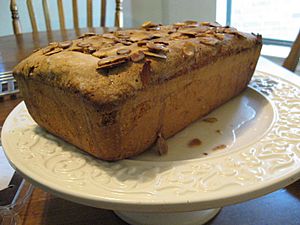Pound cake facts for kids

A pound cake with almonds
|
|
| Main ingredients | Flour, butter, sugar, and eggs |
|---|---|
| Variations | Addition of flavorings or dried fruits |
A pound cake is a yummy type of cake! It's called "pound cake" because it was traditionally made with a whole pound of each of its four main ingredients: flour, butter, eggs, and sugar. These cakes are usually baked in a loaf pan or a special round pan called a Bundt mold. People often enjoy them plain, with a dusting of powdered sugar, a light glaze, or even a layer of icing.
Contents
History of Pound Cake
Pound cake is thought to have started in northern Europe. It dates back to the early 1700s. One of the very first recipes for pound cake appeared in the first U.S. cookbook. This book was called American Cookery and came out in 1796.
Over time, the ingredients for pound cake changed a bit. For example, in 1851, a writer named Eliza Leslie used 10 eggs in her recipe. She also added the juice of lemons or oranges. This made the cake taste and feel different.
An early version of this cake used cornmeal instead of some of the flour. Cornmeal is made from dried corn. This was sometimes called Indian meal. A recipe for Indian pound cake was first printed in 1828. It was later included in a book published in London in 1846. This was when people in Ireland were looking for cheaper alternatives to wheat flour.
Different Kinds of Pound Cake
There are many different ways to make pound cake today. Different countries and regions have their own special styles. People might add flavors like vanilla extract or almond extract. They might also add dried fruits such as currants or dried cranberries.
Sometimes, people change the original recipe to make the cake lighter. They might add baking soda or baking powder. These ingredients help the cake rise and make it less dense. Some recipes use cooking oil instead of butter. This can make the cake moister.
A popular type in the United States is sour cream pound cake. It uses sour cream instead of some butter. This also makes the cake moist and gives it a slightly tangy taste. Even with these changes, the cake is often still called a pound cake! Let's look at some of these variations.
French Style: "Quatre-Quarts"
In France, pound cake is very well known. They call it "quatre-quarts". This name means "four quarters." It's because the cake traditionally uses equal weights of its four main ingredients. In the French region of Brittany, the traditional "quatre-quarts" has no added fruit.
However, in French-speaking parts of the Caribbean, they sometimes add rum for Christmas Eve. They might even add mashed bananas for extra moisture. Some French recipes use beaten egg whites instead of whole eggs. This makes the batter lighter. Other versions include chocolate or lemon juice for flavor.
Mexican Style: "Panqué"
In Mexico, pound cake is called panqué. The basic recipe for Mexican panqué is very similar to the traditional U.S. recipe. The most common types are panqué con nueces. This means pound cake with walnuts. Another popular one is panqué con pasas, which is pound cake with raisins.
Colombian and Venezuelan Style: "Ponqué"
Ponqué is the name for pound cake in Colombia and Venezuela. The word ponqué sounds a lot like "pound-cake" in Spanish! This cake is usually soaked in wine and covered with cream or sugar. Ponqué is very popular for birthdays, weddings, and other big parties.
German Style: "Rührkuchen"
In Germany, a similar cake is called Rührkuchen. This means "mixed-batter cake." It refers to any cake made by mixing flour, butter, eggs, sugar, and often milk. The idea of using equal amounts of the first four ingredients isn't as common here. However, this type of batter is the base for many popular German cakes.
By adding nuts, cocoa, dried fruits, or alcohol, and using different shaped pans, many traditional German cakes are made. For example, this batter is used for cakes baked in a loaf tin. These include Orangenkuchen (orange cake) or Nusskuchen (hazelnut cake). It's also used for marbled cakes in a Bundt tin, called Marmorkuchen. Other flavor combinations are made in shaped tins, like Osterlamm (Easter Lamb) with vanilla and rum.
See also
 In Spanish: Pound cake para niños
In Spanish: Pound cake para niños



